This blog post was written by History Major Helen Hutchinson ’24 and is posted in celebration of the new Tiedtke Theatre and Dance Centre which officially hosted its debut performance, Metamorphoses, this month, in November 2023.
Rollins has had a history of appreciating the arts since its founding, but little space was provided for the purpose of performing musical and theatrical talent in the school’s early years. Recreation Hall served as the primary venue for any kind of performance on campus as of the mid 1920s, but without a dedicated stage performers’ talents were far less visible. Between 1932 to 1974 three buildings were constructed on campus that gave the arts beautiful, functional, and intentionally designed spaces to thrive: Knowles Memorial Chapel, Annie Russell Theatre, and Keene Music Hall. The careful designs of these buildings aimed to provide dedicated spaces for a special student experience — excellence in the performing arts. With such wonderful amenities, students were able to expand their musical or performing talents without limits, ensuring that the arts thrived at Rollins. Furthermore, these structures allowed for performance and music to be enjoyed by campus and community members in new and different ways, enhancing the experience for all audiences.
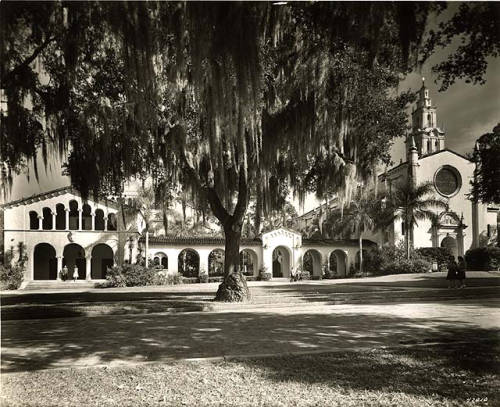
Pictured is the Annie Russell Theatre and Knowles Memorial Chapel from 1940. https://www.jstor.org/stable/community.39301407
Knowles Memorial Chapel
The Knowles Memorial Chapel was built in early March 1932. Ralph Adams Cram, the other half of the Cram & Ferguson Architect firm, was hired by President Hamilton Holt to design the project.1 The firm was acknowledged nationwide for its impressive resume of classic American architecture including Princeton University Chapel and University of Notre Dame’s dining hall.2 Holt was keen on the Chapel being built in coherence with classical 17th-century Mediterranean and Spanish style architecture.3 Mediterranean style became popular during the roaring twenties as it symbolized a building’s wealth and status.4 The finished product reflected the combination of Cram’s talent and Holt’s dream. Cram’s design caught the attention of a student reporter for the Sandspur. The brief interaction between student reporter Dave Bothe and Dr. Cram made it clear that Cram had elaborated on his choice of modified colonial and eclectic design.5 The intricate pinnacles, embattled parapets, carved stone tympanum, and massive bell in the Chapel tower gave the structure timeless character. The interior of the building also had to impress. Multiple treasures embellish the Chapel including a hand carving of The Last Supper by sculptor Ernest Pelegrini and stained glass windows dedicated to four individuals including President Holt and Mrs. Frances Knowles Warren, the Chapel’s primary donor.6
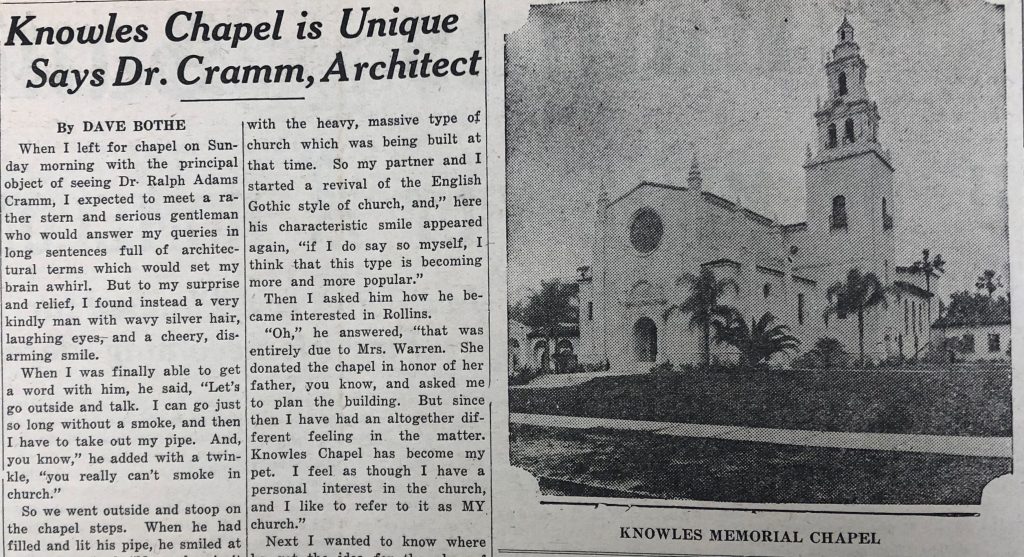
Student reporter for the Rollins Sandspur, Dave Bothe, interviewed Ralph Adams Cram in 1932 after Cram attended a service at the Chapel. [“Cramm” is a misspelling in the article.]
https://stars.library.ucf.edu/cgi/viewcontent.cgi?article=1349&context=cfm-sandspur
The intentional design of the beautiful Chapel provided novel opportunities for musical experiences, both for the audience and performers. The performance of Bach’s Mass in B minor in 1935 opened the gateway to the Chapel being used for not only religious purposes but also musical talents more broadly.7 Devoted music community member Mrs. Isabelle Sprague-Smith and donor Mrs. Frances Knowles Warren combined their efforts and talents to found the first Bach Festival Society in Winter Park. The Bach choir (now referred to as the Bach Festival) became a valued part of the Rollins and Winter Park community. The Chapel also provided a practice and performance area for the choir, giving students and public the opportunity to enjoy a professional orchestra accompanied by incredible vocalists. Today Professor John V. Sinclair serves as the Artistic Director and Conductor of the Bach Festival Society and is the Director of Music at the College.8 With the Bach Choir’s success in the Knowles Memorial Chapel it’s no wonder Rollins students were keen to join the Chapel Choir and Staff. Vocalists in the current music program enjoy the same privilege still.
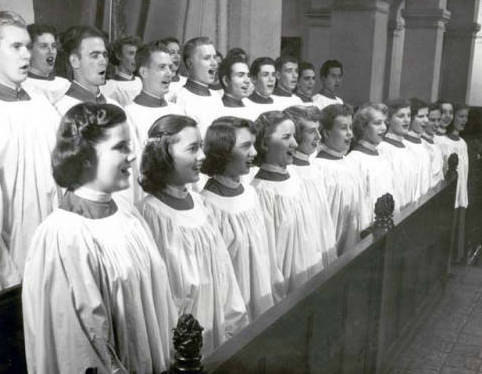
Chapel Choir of 1950 – 1951 performing in the Knowles Memorial Chapel. https://www.jstor.org/stable/community.38481757
Furthermore, since the building’s opening in 1932, students were able to practice in the space and observe performances to enhance their musical skills. Students performed regularly at Sunday services to churchgoers in the Chapel too, attended by both students and locals.9 Fred Rogers ’51, known nation-wide as Mister Rogers, was highly involved in the Chapel’s events and extracurricular activities during his time at Rollins. He was a member of the Chapel staff, the After Chapel Club, the Chapel Choir, and the Bach Choir – making the most of the Chapel and its musical opportunities nearly twenty years later.10 It’s clear that students’ lives were enhanced with the opportunities the Chapel granted them.
Annie Russell Theatre
Simultaneously, the Annie Russell Theatre was planned and built in 1932. Annie Russell was a British-American stage actress who made a large career on stage and eventually retired to Winter Park.11 Her legacy was without doubt impressive, therefore it was only appropriate for the building to embody a special grandeur. The Theatre was designed by Richard Kiehnel, a respected architect from Miami.12 Kiehnel was renowned amongst architectural moguls and was awarded fellowship in The American Institute of Architects for his introduction of Spanish Colonial style to South Florida.13 His style of design paired nicely with Cram’s and the Theatre and Chapel’s close proximity worked well together, as if in harmony. Honoring the elements of nature and incorporating them into the building was also important to the architect. Originally plans for an open-air structure were included in the blueprints for the Annie Russell Theatre, as an homage to inner courtyards in the traditional Spanish Colonial style, but that concept was later scrapped.14
The structure was built with minimal windows but included many arches, a common feature found in this special type of architecture. The original interior of the Annie Russell Theatre in the 1930’s was impressive but became outdated by the mid 1970’s. Later 20th century renovations to the Theatre included lighting, seating, carpeting, painting, a new box office area, restroom facilities, re-roofing, and eventually (in the 80’s) a scene shop serving as a specialized workspace for props and costumes.15The Theatre’s large square footage and seating capacity provided ample room for the dramatic Arts at Rollins to thrive.
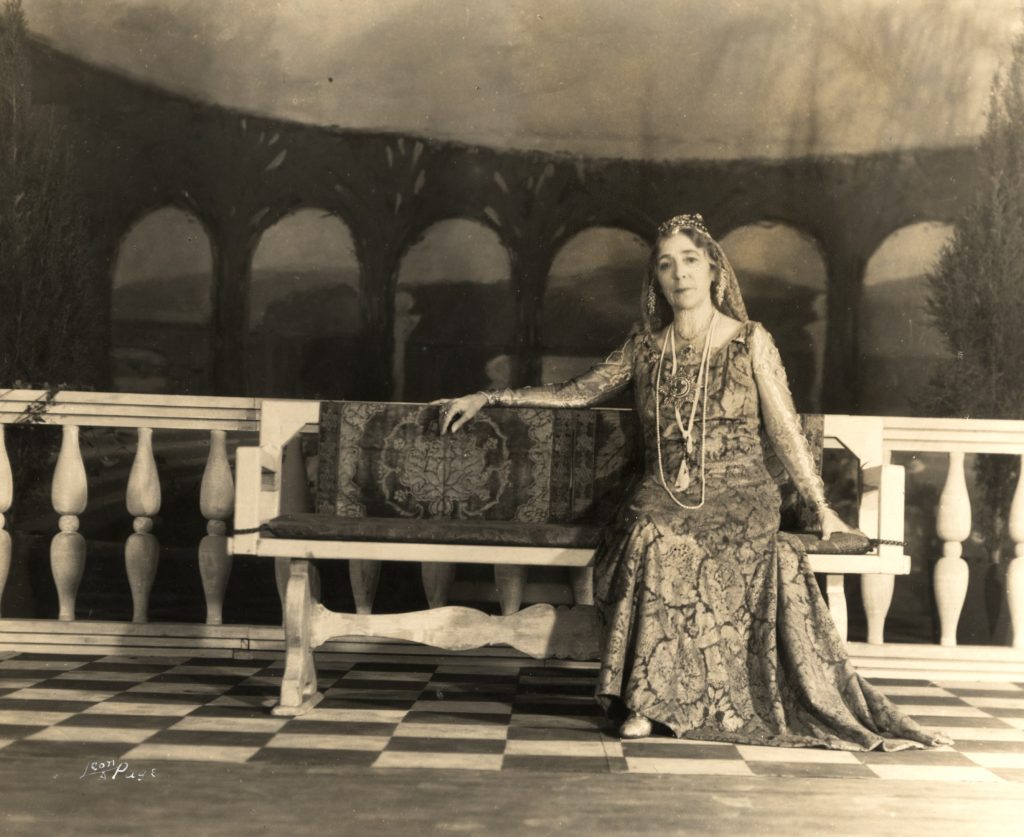
Annie Russell came out of retirement to appear in the Theatre’s first performance, “In the Balcony”. https://www.jstor.org/stable/community.39301106
Audiences have been able to watch and enjoy an array of plays at the Annie Russell Theatre since its opening in 1932. Annie Russell herself starred in the first performance, In a Balcony, when the Theatre first opened. The Theatre has had a performance season every year since its opening, highlighting its success amongst audiences. With such extensive amenities provided in the Theatre and the later renovations modernizing the building, audiences have been able to enjoy the performances across generations without hesitation.
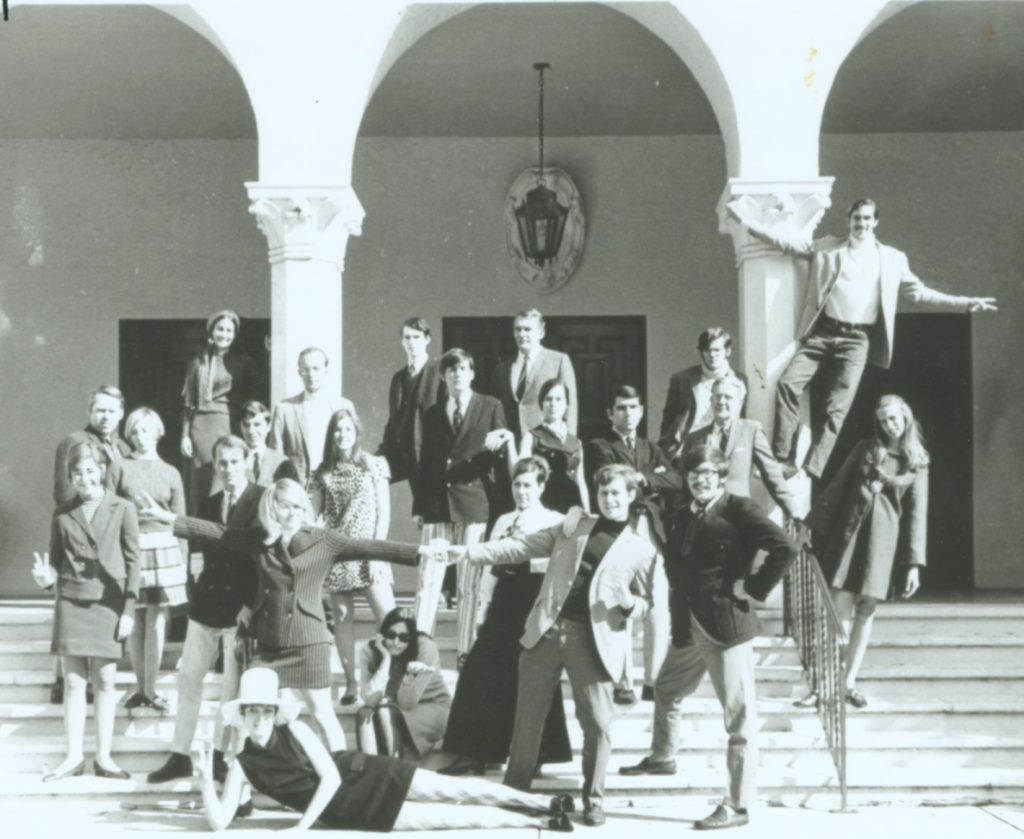
Rollins Players of 1968 – 1969 standing outside the front of the Annie Russell Theatre. These students participated in five to six productions annually at the Theatre. https://www.jstor.org/stable/community.38481746
For students, the opening of the Theatre and its special features gave them new opportunities to explore the world of performing arts. Anthony Perkins, who later advanced his career in Hollywood, won the Theta Alpha Phi award for his undeniable talent on stage in 1953.16 Despite the Theatre not opening until 1932, dramatic arts had still been a core part of students’ prior tot he 1930s. In 1922 the Rollins Players was established and consisted of students who participated in various theatrical activities.17 More than one hundred years later, the Rollins Players continue to bring improvisational acting and comedic creativity to campus as the Rollins Improve Players (RIP) group.18
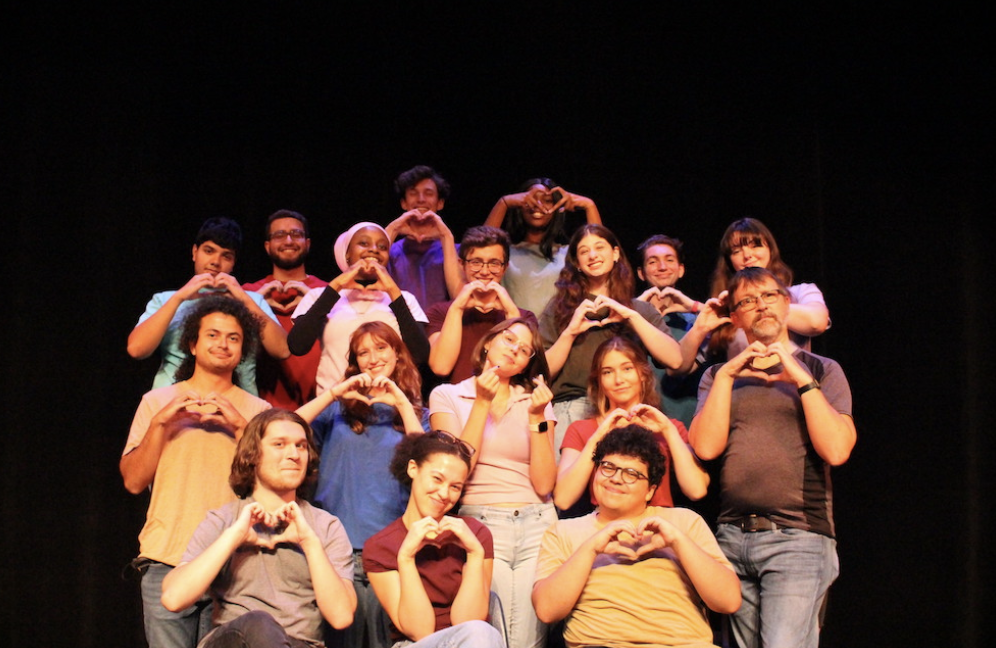
While the Rollins Players have continued their legacy on campus, new groups have formed including the Rollins Improv Players (R.I.P.) who perform theatrical improvisation to eager audiences.
https://www.rollins.edu/annie-russell-theatre/second-stage/rollins-improv-players.html
Keene Music Hall
The Knowles Memorial Chapel and Annie Russell Theatre served as beacons of light for Rollins performers, but there was any empty plot waiting to facilitate instruction and education. In 1974, the legacy continued and Keene Hall was constructed. Named after Florida Citrus Hall of Fame inductee Rudolphus Dutch Keene, the project was funded by the Keene Family Foundation, the Kresge Foundation, and the McFeely-Rogers Foundation.19 Keene Hall was designed by Schweitzer Associates. Compared to the Knowles Memorial Chapel and Annie Russell Theatre, Keene Hall is visually much more humble in design with little if any focus on 17th century Mediterranean style architecture.20 Minimalism, simplicity, and functionalism were favored during the 1970’s and this is reflected in the modernism structure of Keene Hall. The interior halls of the building told a different story; the Rogers Room, soundproof practice studios, music library, smart classrooms, high-tech recording studio, two Steinway D Concert grand pianos, and John M. Tiedtke Concert Hall gave the Department of Music and its students endless possibilities to explore.21
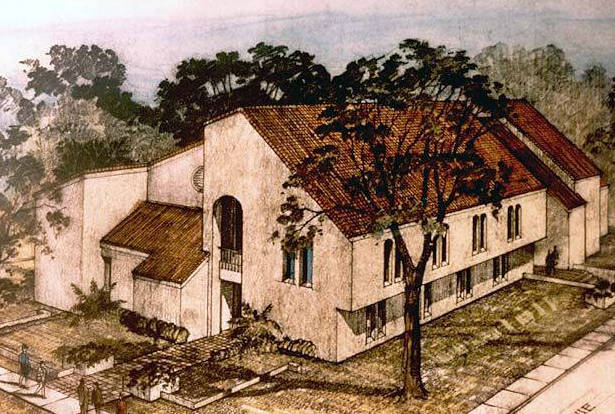
Keene Music Hall was designed by Schweitzer Associates and constructed by Allen Trovillion. The building (original rendering above) was funded by the Keene Family Foundation, the Kresge Foundation, and the McFeely-Rogers Foundation. https://www.jstor.org/stable/community.39301826
The 400-seat John M. Tiedtke Concert Hall allowed larger numbers to experience the magic created by the Department of Music. Today, the Bach Festival frequently uses the Tiedtke Concert Hall for choral and instrumental concerts. Audiences have loved the events so much that sketches and articles have been published, commenting on the fabulous acoustics of the newly-renovated Tiedtke Hall in 2011.22 Keene Hall has also seen famous figures walk through its door including violinist Itzahk Perlman, opera singer Jessye Norman, and conductor Leon Fleisher.23 Such workshops and performances provided by Keene Hall’s visitors drive and inspire students to vigorously pursue their musical talents.
Thomas Thorspecken, author and artist of Analog Artist Digital World Blog, attended an electric bass-faculty recital hosted at John M. Tiedtke Hall in February, 2011. Photo courtesy of Analog Artist Digital World.
https://analogartistdigitalworld.com/tag/tiedtke-concert-hall
Keene Hall provides space for students to enhance their skills. The Department of Music’s rich syllabi, including musicianship courses and electives as well as performance and ensemble opportunities, helps introduce the student to specialty performance pathways and skills. Students have also been a part of creative collaborations with local community groups such as SHARP Musical Experiences – presenting musical concerts for those with special needs.24 Student organizations such as Phi Mu Alpha, Sigma Alpha Iota, Pi Kappa Lambda, and the Music Advisory Council give students plenty of other playing experience via the Rollins Department of Music’s many connections.
Tiedtke Theatre and Dance Centre
Rollins’ ongoing and intentional pursuit of excellence for the performing arts can be seen still today. The groundbreaking of the new Tiedtke Theatre & Dance Centre in November 2022 due to a generous $5 million donation from Philip and Sigrid Tiedtke continues the long legacy of housing the Arts at Rollins, creating new spaces for future generations of performers.
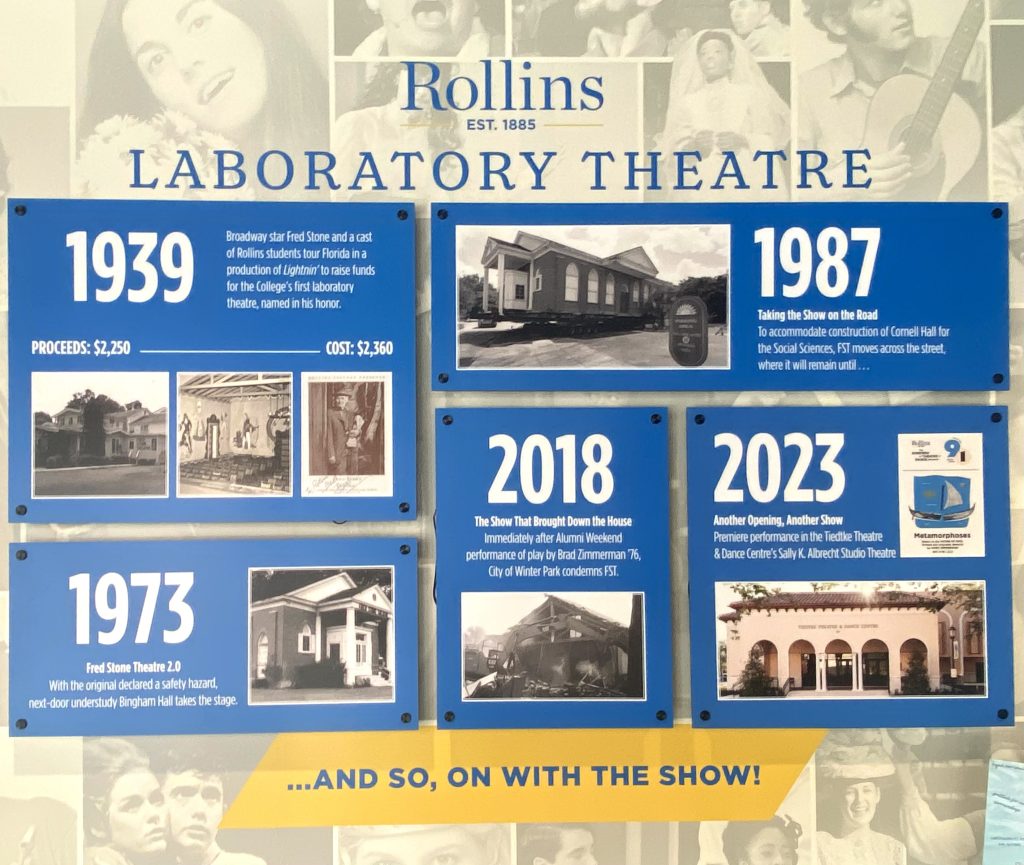
A permanent display explaining the history of laboratory theatre at Rollins greets visitors in the new Tiedtke Theatre & Dance Centre (see image above). The College Archives team was honored to collaborate with the Theatre Department on this special project.
This 16,165 square foot, brand new, state of the art performance facility stands adjacent to the Annie Russell Theatre and just north of Keene Music Hall, providing an anchor to the neighborhood of performing arts buildings on Rollins campus. The Baker Barrios architectural firm designed the new space to perfectly suit Rollins’ iconic Mediterranean architecture style, and the firm made sure to incorporate flexible, technology-centered spaces to the building’s interiors in critical ways. Far more than a simple black box theatre, this new facility houses the Sally K. Albrecht Studio Theatre, the Fred Stone Acting & Directing Laboratory, and the Design & Technology Laboratory — three intentionally designed performance classroom spaces for improvisational and musical workshops and hands-on theatrical design experiences. Furthermore, the new Tiedtke Center is also home to a 2,400-square-foot Wynee Warden Costume & Technology Studio which serves as a costume shop and experimentation space for props and regalia. Finally, an innovative Yeager Light Lab offers a whole new approach to visual storytelling with a working model theatre.25 For Rollins Arts majors, today and before, opportunities for learning and growing in their performance craft seem to be limitless.
About the Author

ENDNOTES:
[1] Wenxian Zhang, Denied Bano, Charles Steves, Rollins Architecture: A Pictorial Profile of Current and Historical Buildings (Self-Published, 2009), 58-59.
[2] “Classic American Architecture,” Cram & Ferguson Architects, accessed May 4, 2023, https://www.cramandferguson.com/about.
[3] Wenxian Zhang, Denied Bano, Charles Steves, Rollins Architecture: A Pictorial Profile of Current and Historical Buildings (Self-Published, 2009), 58-59.
[4] Monique C. Valeris, “Everything You Need To Know About Mediterranean-Style Houses,” Elle Decor, accessed May 4, 2023, https://www.elledecor.com/design-decorate/interior-designers/a28109399/mediterranean-style-house-architecture/.
[5] David Bothe, “Knowles Chapel is Unique Says Dr. Cramm, Architect,” The Rollins Sandspur, Nov. 05, 1932. [Cramm was misspelled in the article. The architect’s name is Cram.]
[6] Wenxian Zhang, Denied Bano, Charles Steves, Rollins Architecture: A Pictorial Profile of Current and Historical Buildings (Self-Published, 2009), 58-59.
[7] “Bach Festival Society 1936-1981,” n.d. (circa 1981), Warren, Frances Knowles: Bach Festival, Warren, Frances Knowles, Trustee Files, Rollins College Archives and Special Collections (hereafter cited as RCASC).
[8] John V. Sinclair: Artistic Director and Conductor,” Bach Festival Society of Winter Park, accessed May 4, 2023, https://www.bachfestivalflorida.org/artistic-director.
[9] “Chapel Choir of 1950 – 1951 sings in the pew,” ca. 1950 – 1951, Rollins Digital Collections, https://www.jstor.org/stable/community.38481757.
[10] Bobby Davis, “Farewell to our Favorite Neighbor,”Rollins News, accessed May 4, 2023, https://www.rollins.edu/news/farewell-to-our-favorite-neighbor/.
[11] “Annie Russell Theatre: History,” Annie Russell Theatre, accessed May 4, 2023, https://www.rollins.edu/annie-russell-theatre/history/#leftNav.
[12] Wenxian Zhang, Denied Bano, Charles Steves, Rollins Architecture: A Pictorial Profile of Current and Historical Buildings (Self-Published, 2009), 62.
[13] Guzman Kolaya, “Kiehnel & Elliot Coconut Grove Survey,” Kiehnel & Elliot, accessed May 4, 2023, https://dadeheritagetrust.org/wpcontent/uploads/2021/07/KIEHNEL_FINAL_ll.pdf
[14] “Annie Russell Theatre Construction Blueprints from March 1931,” March 1931, Rollins Digital Collections, https://www.jstor.org/stable/community.39301398.
[15] “Annie Russell Theatre,” Olin Archives, accessed May 4, 2023, https://lib.rollins.edu/olin/Archives/Architecture/Arch/annie_russell_theatre.htm
[16] “Anthony Perkins on the Annie Russell Theatre Stage,” 1953, Rollins Digital Collections, https://www.jstor.org/stable/community.39300929.
[17] “Rollins Players of 1968-1969,” ca. 1968 – 1969, Rollins Digital Collections, https://www.jstor.org/stable/community.38481746.
[18] “Rollins Improv Players,” Annie Russell Theatre, accessed May 4, 2023, https://www.rollins.edu/annie-russell-theatre/second-stage/rollins-improv-players.html.
[19] Wenxian Zhang, Denied Bano, Charles Steves, Rollins Architecture: A Pictorial Profile of Current and Historical Buildings (Self-Published, 2009), 95.
[20] “Architect’s Plan for Keene Music Hall,” ca. 1974, Rollins Digital Collections, https://www.jstor.org/stable/community.39301826.
[21] Wenxian Zhang, Denied Bano, Charles Steves, Rollins Architecture: A Pictorial Profile of Current and Historical Buildings (Self-Published, 2009), 95.
[22] Thor, “Brass Ensemble,” Analog Artist Digital World. accessed May 4, 2023. https://analogartistdigitalworld.com/tag/tiedtke-concert-hall
[23] “Department of music: Overview,” Rollins College, accessed May 4, 2023, https://www.rollins.edu/music-department/index.html.
[24] “Department of music: Creative Collaborations,” Rollins College, accessed May 4, 2023, https://www.rollins.edu/music-department/creative-collaborations/index.html.
[25] “First Look: Tiedtke Theatre & Dance Centre,” Rollins College, accessed on November 15, 2023, https://www.rollins.edu/college-of-liberal-arts/news/first-look-the-rollins-college-theatre-and-dance-centre/.
